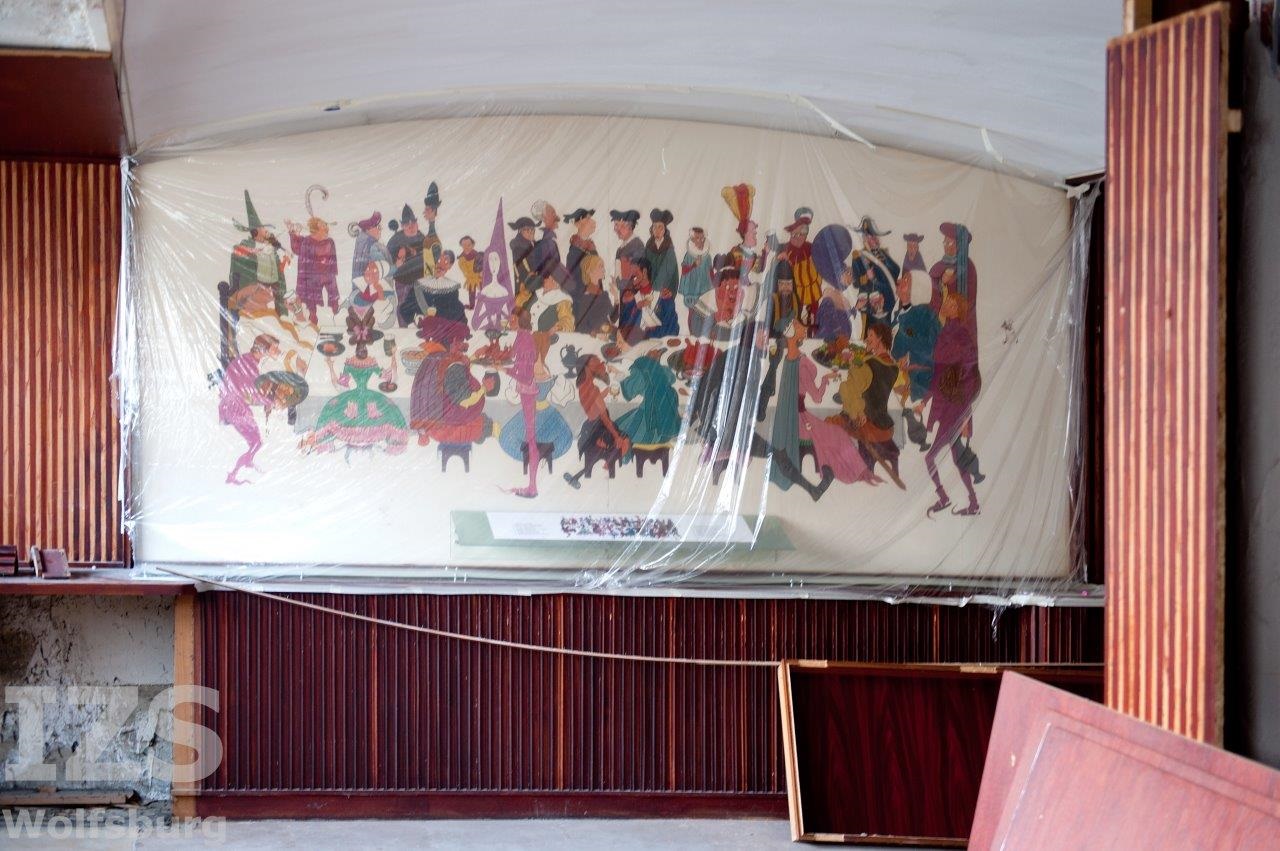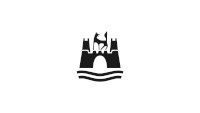Council committee, Horus Engels (1958)
From Maik Ullmann
Hardly any other artist is represented in Wolfsburg's urban space with his works as much as Horus Engels. Whether with the ram's head, the colloquial name for the fountain sculpture in the municipal VW swimming pool, the mural The Postman on the façade of the former post office building on Brandenburger Platz or the fairy tale pictures, a ten-part cycle with depictions of different fairy tales from the world of the Brothers Grimm in the Leonardo Da Vinci Comprehensive School - his works are usually visible in central locations in the city. Since the closure of the Ratskeller, however, one of his murals in the basement of Wolfsburg Town Hall is no longer visible to the public. This is fatal insofar as Horus Engels' Council Panel from 1958 can be interpreted as one of his most important works from the perspective of the city's history (Fig. 1). However, it is not known how Engels came to this commission.

Richard Engels, known as "Horus" after the character of the same name in Bertha Eckstein-Diener's novel The Cone Sections of God,-__-0000-__- is one of the outstanding personalities in Wolfsburg's still young art history. After the painter and sculptor returned to Germany from seven years as a Soviet prisoner of war in 1948, Horst Arndt Karl Ludwig Engels, born in London in 1914 to an American father and a German mother, made the young city of Wolfsburg his adopted home. Having spent the previous years as a soldier in the Wehrmacht and a prisoner of war, he ventured a new start as a freelance artist in the midst of the post-war chaos of the "barrack town" in Lower Saxony. However, the omens for this were by no means good, as Engels was neither established in art at the time nor could he prove that he had any previous artistic training. Nevertheless, over the next forty years he became one of Wolfsburg's most sought-after artists. His works adorn the fronts of houses, are exhibited in schools and have also achieved fame beyond the borders of Wolfsburg. Fairytale pictures and fantasy worlds are among his most frequent motifs. It is therefore not surprising that the painter was a great admirer of the legendary world of J.R.R. Tolkien. After reading Tolkien's work, he wrote enthusiastically about its impact: "Wolfsburg was enchanted. The great forests came alive with Tolkien's characters. Elves peeked out from behind the great oaks of the North Woods, Bilbo Baggins seemed to live in a cozy village in Lower Saxony, and the nearby Harz Mountains with their rocky cliffs were reminiscent of the looming Misty Mountains." -__-0001-__-
Fascinated by Tolkien's writings, Engels campaigned for a translation of The Hobbit into German, for which he wanted to contribute the illustrations. However, J.R.R. Tolkien did not seem to be overly convinced by Engels' designs, as a letter from 1946 to the British publisher Sir Stanley Unwin, who was also to publish the novel cycle The Lord of the Rings (1954/55) alongside The Hobbit, shows:
"I keep getting letters from poor Horus Engels about a German translation. -__-0002-__- He has sent me a few illustrations -__-0003-__- which, despite some merits, as one might expect from a German, are unfortunately too much -__-0004-__- for my taste: Bilbo with a runny nose and Gandalf as a vulgar figure of fun, rather than the Odin-like wanderer I think of..." -__-0005-__-
Engel's perseverance paid off nonetheless. In 1957, Little Hobbit and the Great Wizard was published in Walter Scherf's first German translation together with the illustrations by Horus Engels by Paulus Verlag in Recklinghausen.
Not unlike the wizard Gandalf, Engels also chose a life of seclusion and closeness to nature: "I need the quiet forests, the dreamy Lower Saxony countryside, our little horse Tassilo and the many good friends. I am happy in the poetic house by the romantic Neuhäuser Burgteich pond, right next to the large rhododendron." While the Schlossstraße 8 artists' group led by Peter Szaif and Rudolf Mauke helped to shape and shape artistic events in the public sphere, Horus Engels was seemingly detached from all of this and went his own way. In Wolfsburg, the artist was known as the "Hermit of the Wasserburg". He lived in seclusion in the Wolfsburg district of Neuhaus on Wehmann'schen Hof, where his gallery and exhibition space "Hühnerstall" was also located. His works, mainly paintings, found a wide range of buyers. At the end of the 1980s, parts of his works were reunited at an exhibition in Wolfsburg's Bürgerhalle. At the end of the 1950s, Wolfsburg was regarded as a "city without tradition", -__-0006-__- but at the same time endeavored to establish one. -__-0007-__- The working-class city longed for cultural prestige. The painter evidently picked up on this urban discussion about its lack of tradition and painted a scene resembling a medieval banquet on a wall in the town hall cellar even before it was completed. -__-0008-__- With his council committee, he created an imaginative depiction of Wolfsburg's city council and its administrative leaders from 1952 to 1956. However, "King" Heinrich Nordhoff, -__-0009-__- the general director of the Volkswagen factory, who would probably have made an excellent figure in Engel's painting on account of his unofficial title alone, is nowhere to be found. On an area of 370 by 160 centimeters, Engels painted a banquet table extending across the entire span of the picture (fig. 2), at which numerous people of both sexes are engaged in lively conversation. No fewer than 16 men from the upper echelons of local politics can be identified among them. However, this grotesque-looking council body is not chaired by the mayor in office at the time, Arthur Bransch, who is depicted in the upper third in the center wearing a medieval magistrate's robe with an implied chain of office and is surrounded by city planning officer Peter Koller, clearly recognizable by his high forehead and flowing head of hair, Senator Günter Schoefer and senior city manager Wolfgang Hesse, as well as councillor Fritz Hesse, who is somewhat removed from the group. None other than Thietmar von Merseburg,-__-0010-__- bishop during the Ottonian reign in the 11th century, had apparently been invited to the table here. He assumes the position of the amused observer. Clad in a white robe with a golden hem, a glass of wine in his hand and a piece of meat on a plate in front of him, the clergyman gazes amusedly into the circle of Wolfsburg's who's who of local politics cavorting around the lavishly laid table.

Engels clearly admired this important chronicler of the Saxon imperial period, and he evidently also saw himself as a narrator of his own time. While the bishop from the High Middle Ages documented the history of the city of Merseburg with a special focus on the kings of Saxony in eight extensive volumes, the Wolfsburg artist took up his brush for his painting Ratsgremium and arranged the spirit of optimism that prevailed in Wolfsburg in the 1950s, fueled by the 'economic miracle'. Alongside other politicians such as Mayor Uwe-Jens Nissen and Chief Town Clerk Wolfgang Hesse, the old Prussian landed gentry were not allowed to stay away from the banquet: Günter Graf von der Schulenburg, apparently stylized as an "Arab" in accordance with his passion for horse riding, is on the right-hand edge of the painting in the company of a miniature version of Councillor Peter Cadera, dressed as a master baker, and the former naval officer Councillor Friedrich Spies, -__-0000-__- who is depicted in the uniform of one of the same kind from the time of the Wars of Liberation, and thus stands out visually in particular. Horus Engels also immortalized himself in his painting: smoking a pipe, equipped with a piece of paper and pen, the painter hides at the feet of the company under the richly laid council table.
The painter sought to preserve the magic that fascinated Engels so much about the Lord of the Rings saga in his depiction of the council. The feasts were often magical moments in Tolkien's work; Bilbo's big birthday party comes to mind in particular. The feast as a place where alliances are forged is a recurring motif in the stories of Frodo and the Ring and evidently inspired the artist to transport the Wolfsburg players from politics back to a seemingly timeless fantasy world in which the Middle Ages, modern times and the modern age collide. Where else would something like this be possible if not in the "city without history" on the Mittelland Canal?
Sources
-__-0000-__- "Profiles (83): Finding a creative haven of peace in the city", in: Wolfsburger Nachrichten, January 9, 1988.
-__-0001-__- Quoted from "A touch of magic in the city", in: Wolfsburger Nachrichten from November 27, 2017.
-__-0002-__- Humphrey Carpenter/Christopher Tolkien (ed.), The Letters of J.R.R. Tolkien. Boston 1981, Letter 107.
-__-0003-__- Günter Riederer, "Kollektive Erinnerung in einer Stadt ohne Tradition - die Geschichte der Straßenbenennungen in Wolfsburg nach 1945", in: Janina Fuge/Rainer Hering/Harald Schmid (eds.), Gedächtnisräume. Images of History and Cultures of Remembrance in Northern Germany. Göttingen 2014, pp. 309-324; Alexander Kraus, Stadt ohne Geschichte? Wolfsburg as a democratic laboratory of the economic miracle era. Göttingen 2021, introduction.
-__-0004-__- Steffi Crain, "'Junge Stadt sieht junge Kunst' - Wie Tradition entsteht", in: Das Archiv. Newspaper for Wolfsburg City History, no. 5 (May 2017), p. 13.
-__-0005-__- Ratsgremium is not Engels' only work of art in the basement of the town hall. Apparently, the painter portrayed the entire city administration at the time. This was reported by Robert Bartels, a former DP councillor, in an interview with the then archivist Bernhard Gericke in the 1960s. StadtA Wob, EB 1, interview with Robert Bartels from October 18, 1966.
-__-0006-__- "In König Nordhoffs Reich", in: Der Spiegel from August 9, 1955, available online at https://www.spiegel.de/politik/in-koenig-nordhoffs-reich-a-9b7771c6-0002-0001-0000-000031970946 -__-0007-__-.
-__-0008-__- The information is based on a print of the painting with accompanying legend that the city of Wolfsburg produced in the recent past.
-__-0009-__- Werner Strauß, The city's sponsorship of the German Navy minesweeper "Wolfsburg". Archival item of the month - issue 6/2015.
